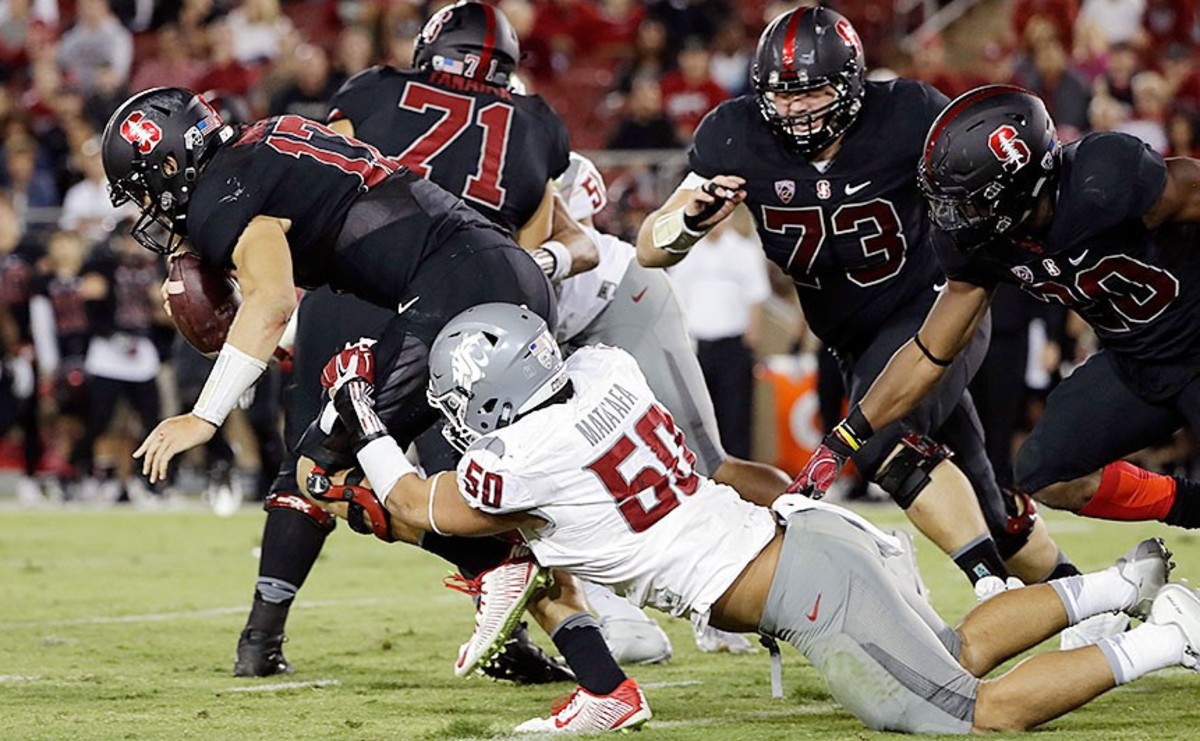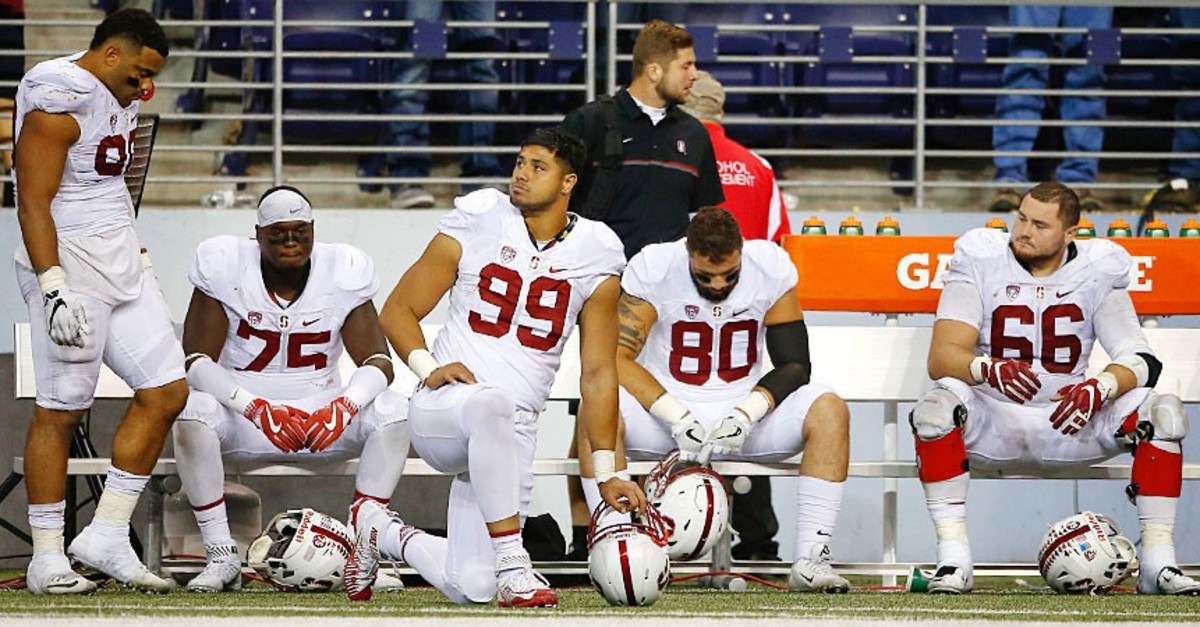Fundamental breakdown: Stanford's glaring struggles most acute at position group it holds most dear

[video: 13724763]
PALO ALTO, Calif. — The appearance of Tucky, the team golden retriever, with a ball in his mouth brings a smile to David Bright's face. It is a welcome afternoon pick-me-up for Stanford's senior guard-turned-tackle, as his weekend has been otherwise suboptimal. On Saturday night, the Cardinal were blasted by Washington State for their second straight loss, which was also the second straight game in which the offensive line did not exactly acquit itself terrifically. Now, following Bright's day-after-game lift and massage, and after reliving the disappointment through some film review, the biomechanical engineering major has homework to do. Mechanics and materials due Monday. Dynamics due Tuesday.
"So it's going to be a fun Sunday for me," Bright deadpans.
Dismayingly, the problem solving for the veteran and his brethren was just beginning. As confounding as any engineering equations are the issues at the heart of Stanford's perplexing 3–2 start.It is uncharacteristic enough for Stanford, which entered the season ranked No. 8 nationally, to endure a losing streak of any kind—the program has dropped consecutive games just one other time since 2010, and that was in November 2014. A preseason Pac-12 favorite, the Cardinal now have virtually no hope of even a Rose Bowl bid, let alone a College Football Playoff invite, making a sudden and severe systems failure like this especially vexing.
All had been going fairly well for three games, and then consistency and physicality and reliability vanished, more or less across the board. While every position is culpable for the team's uneven performance heading into a visit to Notre Dame this weekend, the offensive line's swift deterioration is emblematic and particularly puzzling. The position group is structured to avoid any dip in dependability, being the foundation for just about everything the offense does.
Stanford linemen are, of course, always expected to be brutish and precise. And all those overloaded, extra-jumbo packages give backups some live work that should ease the transition to starting roles. The plan was functioning as intended this year. A relatively inexperienced group trended up before a trip to Washington on Oct. 1…and now the offense ranks 100th nationally in rushing and 108th in sacks allowed per game. "There's not anything [we're doing] that we can say right now that we are a good Stanford offensive line, in terms of what our standard is," offensive coordinator and offensive line coach Mike Bloomgren says, taking a break from scouring Notre Dame film on his office flat screen. "There's nothing where we're reaching that bar. I guess one thing is effort—I love the guys, I love how they work, so we are working our butts off. But we're not getting great results."
THAMEL: Why Notre Dame's Corey Robinson walked away from football
That's problematic with first-year players at quarterback and a former Heisman Trophy finalist in the backfield. The offensive line, in theory, would give Ryan Burns and Keller Chryst the room they need to grow as signal-callers. Meanwhile, it ostensibly would provide space for Christian McCaffrey, he of the 3,864 all-purpose yards in 2015, to produce more large numbers. And against USC and UCLA in the second and third games of the season, Stanford averaged 251 yards rushing and 5.98 yards per carry. Strides were literally being made. Then came Washington's front four on Oct. 1.
The Cardinal offensive line was brutalized in a 44–6 loss to the Huskies, clearing the way for just 29 net rushing yards while allowing eight sacks. Stanford has 90 yards rushing total in its last two games. The Cardinal don't have a rushing touchdown since the USC game. By everyone's estimation, it's a bizarre fundamental breakdown in, well, Stanford fundamentals. "We are a work in progress up front," head coach David Shaw lamented after the Washington State loss. "I didn't think at this point that I would be saying that, but that's just where we are."
Bloomgren aimed to narrow his group's focus after the debacle in Seattle. Work on your punch in pass protection, he told them. Do a great job with your kicks. Don't engage too early. Then strain and finish the block. It's a refresher course in root technique that no one would have guessed any Stanford offensive line would require in any October.

Marcio Jose Sanchez/AP
Improvement was incremental against Washington State; the Cougars recorded three sacks and three more quarterback hurries, and more subjectively, they appeared to dictate the action for most of the night. But a renewed commitment to simplicity might be the only remedy for the Cardinal's abrupt failure, even if it takes some time to take hold. "We just honestly need to get our edge back," Bright says. "The first three games, we were clicking with each other, and I think we still are. But I think we were generally more solid. Guys now, myself included, are making silly mistakes we didn't make those first three games. I don't know why it's happening, because I feel like we were doing well. It's the small things we really have to hone in on."
There are bigger-picture dynamics at work, too. Right guard Johnny Caspers has 31 career starts, including 20 straight. The other four linemen listed as starters for the Notre Dame game have a combined 16 career starts. Moreover, Stanford has rolled out three starting offensive line combinations in five games. Some inconsistency, all things considered, might be expected.
Except it's not expected at Stanford, because Stanford takes pains to avoid inconsistency. Bloomgren calls it an offensive line "internship" program: Jumbo sets demand extra bodies, so younger linemen take on those part-time jobs, getting valuable in-game repetitions. Sometimes it's a dozen snaps a game. Sometimes it's 40 or 50, as it was in 2013, when a tight end shortage dictated that Stanford use offensive linemen at that spot. It's an effective development tool. Joshua Garnett, to cite a recent example, went from offensive line intern to Outland Trophy winner in 2015 to first-round NFL draft pick in May.
BECHT: How far does Stanford slide in latest Bowl Projections?
Bright, who flipped from left guard to right tackle against Washington State, has just five career starts. But he's played in every game for the past three seasons. "When you are ready to come in and start, you do have in the back of your mind that I've already been out there, so it's not completely new," the 6' 5", 295-pound senior says.
Even if there's not a specific internship spot available, there are early training mechanisms. Jesse Burkett, Stanford's first-year starter at center, spent last season drawing up defenses on white boards during games, diagnosing what opponents were doing so Bloomgren could make adjustments. "It helped me get comfortable in our offense so the mental aspect is out of the way," Burkett says. "It's ingrained in us by the time we have an opportunity to play."
As Bloomgren says, the internships typically give Stanford a "jumpstart" on warding off inconsistencies that come with inexperience. He also notes that it is not the same as 65 snaps worth of protections and adjustments and physical toll. Which might explain the current reality. Some groups simply adjust better and quicker than others.
"I've talked about young offensive linemen as the girl in the horror movie—you want to yell at the screen and warn her about what's around the corner," Bloomgren says. "But sometimes as much as you coach them and warn them, the mistake is not avoided. The key is that those hard lessons stick with the guys and they don't make [the mistakes] again."

Otto Greule Jr/Getty Images
Hard lessons have come fast for the Cardinal, though a softening schedule—the remaining seven opponents have a combined 15–25 record—may allow them to work through shortcomings. And there are shortcomings everywhere. Stanford's quarterback play has been mostly unexceptional; Burns has five touchdown passes against three interceptions, and Chryst has a passer rating of 60.5 on just 17 attempts while being deployed mostly as a running option. On the other side, the Cardinal defense has surrendered 40-plus points in the back-to-back losses. Its resilience is fair to question because players are the ones questioning it: After a pick-six brought Stanford within 11 early in the third quarter against Washington State, the defense surrendered a touchdown on the next drive. "That crushed us," defensive end Solomon Thomas says. "I saw guys on the sideline sad. You can't play like that. You can't get sad when someone scores. You have to man up and bust them in the mouth. That's what happens when you don't."
Rarely do the Cardinal need one of their own to deliver an enough-is-enough speech. It's almost unheard of to hear one for two weeks running. But there they were in the locker room, listening to McCaffrey after Washington and Thomas after Washington State. And here they are, trying to turn words into actual results. "Our coaches coach too hard, our players work too hard, we put in way too much time to be playing the way we're playing," Thomas says, paraphrasing his own post-Washington State monologue. "We need to have way more passion, we need to have way more heart on the field, we need to execute way better. We have a lot to fix. We have way too much talent, we're way too good a team to play like that. So don't sulk. Don't look down. Don't think we're not a good football team. We are a great football team, if we want to play like it, if we want to execute."
JOHNSON: Stanford's woes send McCaffrey's Heisman stock dropping
They returned to work this week intending to avoid the first three-game losing streak of Shaw's tenure. For the offensive line room in particular, Bloomgren jokes that the solid start and sudden collapse tempts everyone to treat it like a case of the shanks in the movie Tin Cup—just switch your change from one pocket to the other, and problem solved. "But we know that's not real," he says. No, what's real is Stanford's line unglamorously tending to punches and kicks and effort and brutality. "We're always trying to make every play call—run, pass, whatever—as physical a rep as we can make it," Bloomgren adds. "Because it's just who we are. That's what we need to do for this team, is to impose our will."
It's not unusual for Stanford's offensive line to learn on the job. It is unexpected that front-line players would do this much learning in these jobs. But as Bright left the football complex Sunday into a glorious afternoon just warming up as a season cools down, the senior's predicament was applicable to more than just a mechanical engineering course load: The Cardinal's offensive linemen have their assignments. No choice but to get them right sooner than later.
